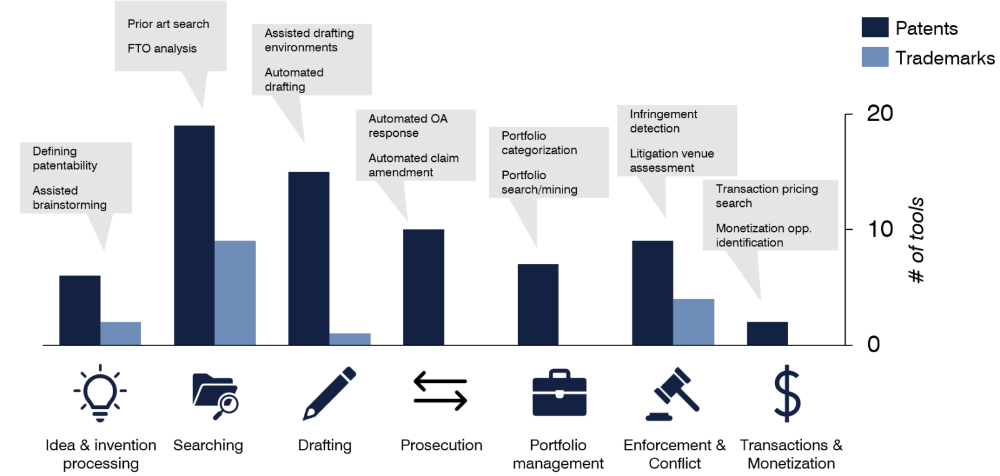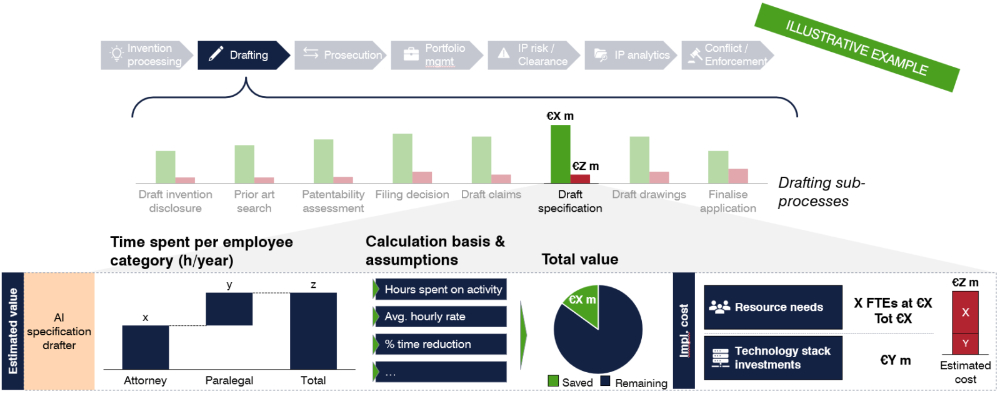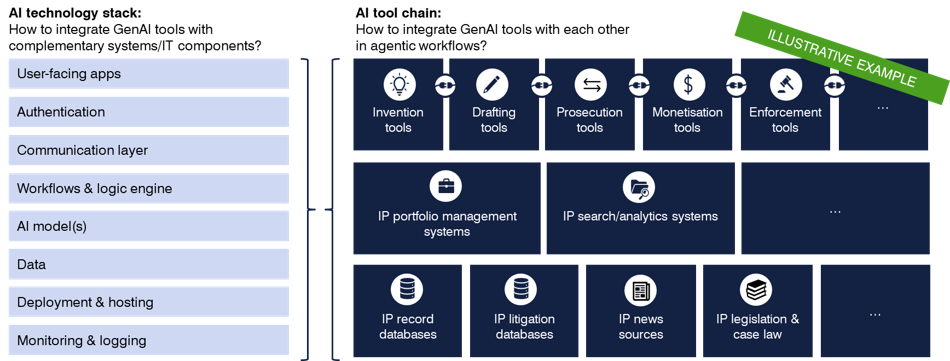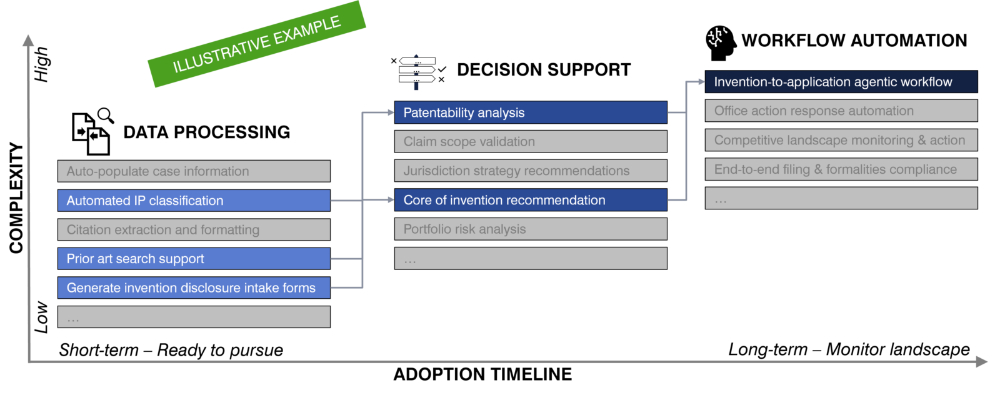- in Europe
- within Technology topic(s)
At a glance
- Exploring Generative AI tools is easy nowadays but embedding them into the fabric of an IP operation and leveraging them at scale, is not.
- The journey towards becoming an AI-enabled IP operation is a strategic move with impact on technology, IP workflows and people.
- The initial question to consider is not "What GenAI tools should we buy?" but "Where can GenAI make the biggest difference in our IP operation? and "How do we ensure our people adopt and are able to use the tools?"
- To succeed in adopting GenAI at scale, IP functions should:
- Prioritize the use cases that provide the most business impact,
- Ensure that tools, complementary systems and data fit well together, and
- Manage GenAI implementation as an organisational transformation
Corporate IP departments are increasingly leaning in on AI
Most organisations are actively exploring AI (and particularly Generative AI, or GenAI) and are beginning to realise meaningful value from using it. The degree of uptake differs across business functions. According to McKinsey's State of AI survey, marketing & sales, product development and IT are forerunners in GenAI deployment, while the risk, legal and compliance functions have been slower in adoption.
The caution regarding confidentiality, output accuracy and governance is however giving way to growing enthusiasm about the transformative potential of GenAI in enhancing an IP operation. Questel's 2025 IP Outlook Research found that 77% of IP organisations express enthusiasm about AI, and 58% claim to regularly use AI tools with a positive impact.
However, exploring the possibilities of GenAI is only the first step. Implementing it at scale and systematically using it in day-to-day work is another story. Many corporate IP departments, IP service providers and IP offices around the world are currently finding themselves stuck in either of two junctures; not knowing where to even start to explore GenAI, or struggling with how to transition from scattered pilot initiatives to scalable implementations.
State of play: A surge of tools along the IP life cycle
The GenAI landscape in IP operations consists of a broad range of tools at varying stages of maturity. The available tools can broadly be categorised as:
- General-purpose GenAI solutions: Versatile tools like ChatGPT or Copilot that can be applied to various tasks but require careful prompting and context-setting to be effectively used in IP-specific scenarios.
- Purpose-built GenAI solutions, sitting on top of data: Tools designed for specific IP tasks, such as patent analysis or trademark searches, which rely on being provided by structured input data and contextual understanding.
- Integrated (monolithic) solutions: Comprehensive platforms, including IP search and analytics suites and IP management systems (IPMS), with embedded AI functionalities that integrate data, analytics and workflows.
While Figure 1 provides a snapshot of the current tool spread, the landscape is growing by the day. Some of the existing patent use cases address parts of prior art searching and patent drafting, both of which aim to significantly accelerate the application process. For trademarks, an example is monitoring online marketplaces to detect infringement. Looking ahead, we see emerging concepts such as AI agents that automate interactions between in-house IP teams, outside counsel, and IP offices. Additionally, predictive analytics tools are being developed to, for example, forecast litigation outcomes and inform risk assessments based on historical data.
Figure 1:
Overview of commercially available AI tools along the patent and trademark lifecycle (March, 2025)

What's happening at the receiving end? – State of AI adoption in IP offices
The interest in AI also exists among IP offices around the globe. Take the USPTO as an example, who have set a concrete target to develop AI expertise within the workforce in the USPTO's AI Strategy from 2025. As a result, nearly 80% of USPTO examiners are using AI-powered features such as similarity searches in their daily work. Similarly, the EPO has rolled out AI-powered services like Pre-Search for prior art discovery, a text-based CPC categorizer, and a legal search tool through the MyEPO portal. In China, CNIPA is scaling up AI across classification and examination workflows. WIPO has claimed a role to lead and enable cooperation amongst IP Offices in the realm of AI tools. They already now offer tools for image similarity search and patent classification that are freely available for use.
Challenges with adopting AI in IP
Organisations often start exploring GenAI by testing different tools through scattered initiatives – without a well underbuilt assessment of the benefits they want to achieve or a plan to get there. While this experimental phase can help build general awareness and reduce resistance to adoption, it rarely delivers real impact. Without a clear view of the problems GenAI should solve or a strategic approach to prioritization, IP functions risk investing in fragmented tools that fall short of expectations and fail to justify the investment.
Access to rich, quality data and clear procedures to govern its use, is a pre-requisite for GenAI tools to perform. Without it, inaccurate output, limited insights and diminished trust among users are bound to follow. Despite this, inadequate data management and complex integrations between GenAI tools and complementary systems are common issues.
Another, and perhaps the most important, pitfall is failing to recognise the organizational impact of AI and the need for change management. Organisations often underestimate the difficulty of embedding new GenAI tools into IP workflows, and the need to upskill IP professionals to effectively utilize these tools. Getting this right matters, however. According to a McKinsey study the re-design of workflows has the most significant impact on any organisation's ability to realise EBIT impact from GenAI. The issue is often caused by not having a structured approach to project management or a dedicated project team in place to drive the process from experiment to scaled adoption.
Case: The challenge to gain traction for great AI ideas as a global IP service provider
At a global IP services company, a small team was informally tasked with driving AI adoption. A dual-track approach was pursued by laying a foundational data infrastructure, while simultaneously identifying GenAI use cases through bottom-up input from across the broader organization. In the absence of a strategy, clear responsibilities and a systematic approach to evaluation, testing and implementation, new opportunities were pursued on a case-by-case basis with limited alignment and organisational awareness around GenAI investments. One selected initiative — a proprietary co-pilot tool — was launched with some initial success, but usage has since varied widely across teams. Without organizational backing or local ownership, even promising solutions struggled to gain traction, underscoring the need for a more coordinated strategy and stronger change management to realise impact at scale.
From supporting clients in navigating this exciting space, we have encountered the above challenges first-hand. Based on our experience, and from interacting with IP executives who are actively working on adopting AI at scale in their IP operations, we have identified three measures to set up an IP function for success.

Enablers in building an AI-enabled IP function
Clearly identify and pursue high-impact GenAI opportunities

As a guiding principle, IP departments should prioritise GenAI use cases that yield the most significant efficiency and effectiveness gains. With so many potential applications available, concentrating resources on a few high-impact opportunities ensures that efforts are focused where they can yield tangible benefits in a reasonable time frame.
To identify top-ranked GenAI use cases, a thorough and data-driven approach is essential. This starts with defining what benefits you are trying to achieve – Reduce costs? Free up people's time? Increase speed in execution? Increase quality?
While efficiency is often the primary driver in selecting which GenAI use case to pursue, other factors should also be considered. Effectiveness measures such as output quality and enabling new capabilities are for example relevant to consider when choosing between alternative tools. Data sensitivity, technical feasibility and softer factors such as workforce acceptance also play a part when evaluating which tools to build/buy and securing buy-in from internal stakeholders. As an example of workforce acceptance, a company that considered introducing an automatic docketing tool relied on feedback from their paralegal team to go ahead with implementation due to the opportunity to reallocate time spent on repetitive tasks to more strategic work, such as portfolio analysis.
To make good calls and convince key decisions-makers, hard numbers are needed to assess each key factor. If the objective is freeing up resources to do other activities, you should look at what the in-house IP team spends most of their time on. If cost reduction is the target, the starting point would be to look at use cases related to the largest piece of IP spend. While gathering data on an IP operation is often challenging and time-consuming, it is worth the effort. External benchmarks are complementary but not a replacement.
When executed correctly, a GenAI use case prioritization exercise provides decision-makers with a business case that clarifies the expected value from selected AI initiatives and estimates the cost of realisation, as illustrated in Figure 2.
Figure 2:
Illustrative approach for prioritizing and building a business case for AI use cases

Case: Thyssenkrupp's approach to adopting high-impact GenAI tools
The IP team at the global industrial group Thyssenkrupp adopts a structured methodology to pinpoint activities suitable for GenAI support. As an example, driven by the goal of increasing efficiency in volume activities, Thyssenkrupp's IP team has chosen to focus on the 'invention to patent application' workflow when exploring GenAI-enabled enhancements due to the high volume of activities performed in this part of the IP lifecycle. Through detailed analysis, they identified seven distinct use cases within this workflow and have implemented various approaches with different AI tools to support execution.
In addition to applying a fair bit of rigor in determining which parts of the IP lifecycle GenAI makes sense, the case of thyssenkrupp illustrates the importance of defining the concrete use case for AI (the need), rather than start to look for tools in the market (the solution). Detail and clarity are what matter here. Formulating a use case as "AI to help attorneys with drafting patent application" is not enough. A use case description should address what concrete steps are taken, what the tool (and what the user) does in relation to each step, which data and instructions are required, what the outputs are and in which format, and what concrete benefit such output provide the users.
Create a cohesive technology architecture

Building a technology stack, or architecture, to power GenAI use cases is necessary when moving from experimenting with tools to operationalising a robust and cost-effective capability. The stack should define how different GenAI solutions are embedded or seamlessly integrated with existing data platforms, such as IP management systems and IP search software. Creating this architecture is particularly important in case an IP function is considering to build its own tools since this also requires general IT components, including storage, large language models and security, as illustrated in Figure 3. The architecture should also enable flexibility to easily add new technologies or replace outdated solutions, as the needs evolve.
In addition to ensuring GenAI tools integrate with other systems, IP functions should also consider how these tools should work well together. For this purpose, leading adopters are starting to develop 'AI agentic workflows' where task-specific tools interact with each other, with or without a human in the loop. This set-up links standalone tools into larger workflows to unlock larger value and foster more scaled adoption. For example, one tool might perform an AI-assisted patent search using an invention disclosure, while another evaluates the patentability of that disclosure based on the search results provided. A third tool may then generate a core of the invention summary to support drafting a patent application.
Figure 3:
Illustrative tech stack for GenAI tools, complementary systems and general IT components

Case: Selecting the right tool for the job
When asked about what guides the selection of vendors for GenAI tools, an IP executive from a multinational materials company highlighted the importance of synergies between tools and interoperability with existing systems. In his experience, even a superior tool will fall short in the competition if it does not seamlessly integrate with other systems.
Corporate IP leaders we have spoken to recently are cautiously optimistic on the maturity of the AI solution ecosystem. Interoperability between tools is improving, but is slowed down by competitive forces between integrated system providers and by uncertainty around the stability of solutions provided by smaller vendors. Consequently, for now, the responsibility for integrating separate GenAI tools into workflows rests with the IP functions themselves.
Manage GenAI initiatives as transformation journeys

Becoming an AI-enabled IP operation is a transformational effort that requires dual focus on technology and organisational change. It is not just a matter of building or integrating new tools – it is equally about calibrating how the IP function works, proactively addressing staff scepticism and concerns, and ensuring that people feel confident, supported, and empowered to adopt AI. In the same way as an IPMS implementation requires IP functions to consider organizational change, GenAI use cases should be assessed for its impact on the IP operating model. In many cases, this means redefining roles, upgrading capabilities, and adapting the way teams work, both internally and with outside counsel.
The immature and fast-changing nature of the GenAI landscape affects how to pursue the transformation journey. While a large-scale rollout of several tools and systems may seem attractive, a gradual, phased integration is often more effective. This involves building an evolutionary roadmap with projects that gradually expand the sophistication and functionality of AI use cases and incrementally increases the adoption rate, as illustrated in Figure 4. This approach reduces risk, delivers value sooner, and gives teams the flexibility to adapt as the ecosystem matures.
At the end of the day, a successful outcome requires people to pick up the tools and start to use them as intended. To build AI capabilities, you need to do more than deploying GenAI solutions and offering prompt engineering training. In our experience with driving transformation of IP functions, a dedicated program team is needed to make change happen. Such a team should include cross-functional expertise in AI/IT, IP and organisational change management to drive both solution development and organisational adoption. To build broader engagement and promote adoption, assigning internal ambassadors can be a valuable addition – especially in large, globally distributed teams.
Organisational readiness also requires clear expectations and boundaries around responsibility and risk. This means creating an environment that encourages experimentation and accepts mistakes as part of learning, while ensuring that individuals remain accountable for work produced using GenAI tools.
Figure 4:
Example of evolutionary roadmap for AI adoption in an IP operations

"We have a portfolio approach to AI projects, where we continuously balance the roadmap based on risk/effort and reward. There are many AI capabilities we would like to have. Some are without roadblocks that we can pursue now. Others are put on pause since the tools available simply aren't good enough or the ecosystem is not mature enough."
– An executive IP leader at a European multinational on AI program design approach
The take-aways
Successfully adopting GenAI in an IP operation requires more than evaluating and buying new tools. The journey starts with clearly articulating GenAI use cases and selecting the ones unlocking the most business benefit. From there, IP functions should to carefully architect a technology stack that ties together the tools and complementary systems required to efficiently power the use cases. Running the implementation as a transformation program ensures that the organisation and its people are ready and able to adopt GenAI tools once they are in place. Finally, a phased approach to building GenAI capabilities will enable IP functions to manage risk, shorten the time to value and provide the flexibility to adapt in the fast-moving ecosystem.
The content of this article is intended to provide a general guide to the subject matter. Specialist advice should be sought about your specific circumstances.




